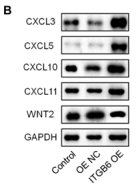| 产品: | CXCL10 抗体 |
| 货号: | DF6417 |
| 描述: | Rabbit polyclonal antibody to CXCL10 |
| 应用: | WB IHC |
| 文献验证: | WB, IHC |
| 反应: | Human, Mouse, Rat |
| 预测: | Pig, Horse, Rabbit |
| 分子量: | 10kDa; 11kD(Calculated). |
| 蛋白号: | P02778 |
| RRID: | AB_2838380 |
产品描述
*The optimal dilutions should be determined by the end user.
*Tips:
WB: 适用于变性蛋白样本的免疫印迹检测. IHC: 适用于组织样本的石蜡(IHC-p)或冰冻(IHC-f)切片样本的免疫组化/荧光检测. IF/ICC: 适用于细胞样本的荧光检测. ELISA(peptide): 适用于抗原肽的ELISA检测.
引用格式: Affinity Biosciences Cat# DF6417, RRID:AB_2838380.
展开/折叠
;Interferon gamma induced factor MOB1, mouse, homolog of; Interferon gamma induced protein 10; 10 kDa interferon gamma induced protein; 10 kDa interferon gamma-induced protein; C X C motif chemokine 10; C7; Chemokine (C X C motif) ligand 10; Chemokine CXC motif ligand 10; Crg 2; CRG2; CXCL10; CXCL10(1-73); CXL10_HUMAN; Gamma IP10; Gamma-IP10; gIP 10; GIP10; IFI10; INP 10; INP10; Interferon activated gene 10; Interferon activated gene 10; Interferon gamma induced cell line; Interferon inducible cytokine IP 10; Interferon inducible cytokine IP10; IP 10; IP-10; Mob 1; MOB1; Protein 10 from interferon (gamma) induced cell line; SCYB10; Small inducible cytokine B10; Small inducible cytokine B10 precursor; Small inducible cytokine subfamily B (Cys X Cys) member 10; Small inducible cytokine subfamily B CXC member 10; Small inducible cytokine subfamily B, member 10; Small-inducible cytokine B10;
抗原和靶标
Mainly secreted by monocytes, endothelial cells as well as fibroblasts. Expressed by epithelial cells in thymus (PubMed:11157474). Microglial cells produce CXCL10 in response to viral stimulation (PubMed:12663757).
- P02778 CXL10_HUMAN:
- Protein BLAST With
- NCBI/
- ExPASy/
- Uniprot
MNQTAILICCLIFLTLSGIQGVPLSRTVRCTCISISNQPVNPRSLEKLEIIPASQFCPRVEIIATMKKKGEKRCLNPESKAIKNLLKAVSKERSKRSP
种属预测
score>80的预测可信度较高,可尝试用于WB检测。*预测模型主要基于免疫原序列比对,结果仅作参考,不作为质保凭据。
High(score>80) Medium(80>score>50) Low(score<50) No confidence
研究背景
Pro-inflammatory cytokine that is involved in a wide variety of processes such as chemotaxis, differentiation, and activation of peripheral immune cells, regulation of cell growth, apoptosis and modulation of angiostatic effects. Plays thereby an important role during viral infections by stimulating the activation and migration of immune cells to the infected sites (By similarity). Mechanistically, binding of CXCL10 to the CXCR3 receptor activates G protein-mediated signaling and results in downstream activation of phospholipase C-dependent pathway, an increase in intracellular calcium production and actin reorganization. In turn, recruitment of activated Th1 lymphocytes occurs at sites of inflammation. Activation of the CXCL10/CXCR3 axis plays also an important role in neurons in response to brain injury for activating microglia, the resident macrophage population of the central nervous system, and directing them to the lesion site. This recruitment is an essential element for neuronal reorganization (By similarity).
Several proteases can mediate post-secretion cleavages. DPP4 cleaves CXCL10 on its N-terminal 2 amino acids leading to an antagonist form of CXCL10. This dominant negative form is capable of binding CXCR3 but does not induce signaling. MMP9 cleaves 9 amino acids instead.
Secreted.
Mainly secreted by monocytes, endothelial cells as well as fibroblasts. Expressed by epithelial cells in thymus. Microglial cells produce CXCL10 in response to viral stimulation.
Monomer, dimer, and tetramer. Interacts with CXCR3 (via N-terminus).
Belongs to the intercrine alpha (chemokine CxC) family.
研究领域
· Environmental Information Processing > Signaling molecules and interaction > Cytokine-cytokine receptor interaction. (View pathway)
· Environmental Information Processing > Signal transduction > TNF signaling pathway. (View pathway)
· Human Diseases > Infectious diseases: Viral > Influenza A.
· Organismal Systems > Immune system > Chemokine signaling pathway. (View pathway)
· Organismal Systems > Immune system > Toll-like receptor signaling pathway. (View pathway)
· Organismal Systems > Immune system > RIG-I-like receptor signaling pathway. (View pathway)
· Organismal Systems > Immune system > Cytosolic DNA-sensing pathway. (View pathway)
· Organismal Systems > Immune system > IL-17 signaling pathway. (View pathway)
文献引用
Application: IHC Species: Mouse Sample: bone tissue
Application: WB Species: Mouse Sample:
Application: WB Species: Human Sample: MMT cells
Application: WB Species: Mouse Sample:
Application: IHC Species: Mouse Sample:
Application: IF/ICC Species: Human Sample: breast cancer tissues
限制条款
产品的规格、报价、验证数据请以官网为准,官网链接:www.affbiotech.com | www.affbiotech.cn(简体中文)| www.affbiotech.jp(日本語)产品的数据信息为Affinity所有,未经授权不得收集Affinity官网数据或资料用于商业用途,对抄袭产品数据的行为我们将保留诉诸法律的权利。
产品相关数据会因产品批次、产品检测情况随时调整,如您已订购该产品,请以订购时随货说明书为准,否则请以官网内容为准,官网内容有改动时恕不另行通知。
Affinity保证所销售产品均经过严格质量检测。如您购买的商品在规定时间内出现问题需要售后时,请您在Affinity官方渠道提交售后申请。产品仅供科学研究使用。不用于诊断和治疗。
产品未经授权不得转售。
Affinity Biosciences将不会对在使用我们的产品时可能发生的专利侵权或其他侵权行为负责。Affinity Biosciences, Affinity Biosciences标志和所有其他商标所有权归Affinity Biosciences LTD.






